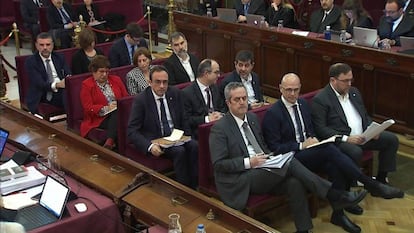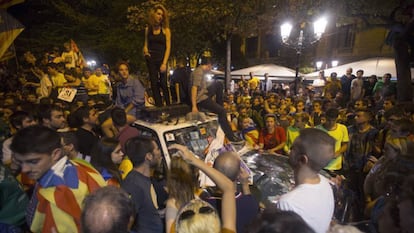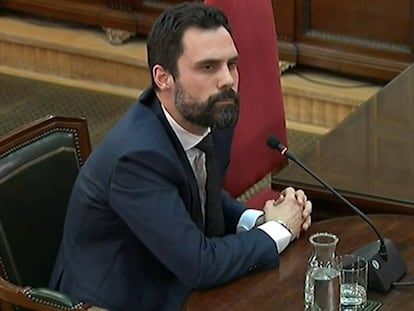At Catalan separatist trial, a tale of scared officials and unpaid invoices
Judges have heard witness testimony from a court clerk who fled a screaming crowd, and entrepreneurs who ended up out of pocket for work they did ahead of the referendum

Witness testimony heard this week at the trial of Catalan separatist leaders in Madrid has shed new light on how the regional government strove to organize the illegal independence referendum of October 1, 2017 without using public money.
The Supreme Court on Wednesday also heard new revelations about how a pro-independence street protest intimidated a court official who was involved in a referendum-related raid on September 20, 2017.
Montserrat del Toro, the court clerk who was with the Civil Guard that day during a search of the Catalan economic affairs building in Barcelona, provided a very different version of events from the claims of the 12 defendants at the trial.
Contrary to statements made in court by Jordi Sànchez and Jordi Cuixart, the leaders of the pro-independence associations ANC and Omnium Cultural, to the effect that the demonstration outside the building was “spontaneous,” “peaceful” and “festive,” Del Toro said that its organizers did not appear very cooperative and that she was “afraid” of being attacked by the crowd if she were to walk out the front door after the search.
Thousands of people had congregated outside the building following a call to action on social media. Video footage shows Cuixart and Sànchez standing on top of a police car, addressing the chanting crowd with loudspeakers. Patrol cars were vandalized and after 16 hours inside the building, Del Toro finally exited through a rooftop courtyard that led to a theater, where she mingled with people walking out after a play.
The court official described seeing “an avalanche” of people outside the building
Before that, she had phoned the judge in a state close to panic, urging him to find a way to get her out of there. She even asked for a helicopter, which was considered unfeasible because of insufficient landing space on the rooftop.
Del Toro said that she walked into the building at 8am and that two hours later there were already “thousands of people” protesting outside. She described seeing “a flood” of people and individuals “crushed against the glass doors.” The police advised her to stay indoors for lunch while the chanting gave way to “screams” and “the typical sounds of a disturbance.” Del Toro said that a Civil Guard lieutenant talked to Sànchez and Cuixart, who appeared to be the protest leaders, and they claimed that they were unable to call off the protest.
The events of that day are key to the prosecution’s claims that violence and intimidation were employed during the independence bid, a necessary condition to uphold the charges of rebellion and sedition against several of the defendants, including former deputy regional premier Oriol Junqueras.

The accusation holds that separatist politicians worked to create the legal framework for an illegal break with Spain while social activists ramped up the street pressure. The defense claims that no violence was employed at any time, that their clients’ actions were legitimate, and that the trial is politically motivated.
Working for free
Also on Wednesday, witness testimony from small-business owners who worked for the Catalan government shed new light on how the latter tried to organize the referendum without using public money. Most of the defendants on trial have also been accused of misuse of public funds.
An advertising entrepreneur named Ferran Burriel explained that he was hired by the regional government to run a newspaper campaign about an alleged “registry of Catalans living abroad” as a way to promote the referendum. Burriel did the job, but was never paid the €80,000 he was owed.
We were told the Generalitat was not going to pay a thing. That we would get paid by a third party
Quim Franquesa, computer scientist
“I asked the Generalitat about the invoice and why it wasn’t being paid. There were queries via email and by telephone,” said Burriel. The money never arrived, but Burriel did not turn to the courts, and he continues to do work for the regional government.
Another witness, a web designer named Teresa Guix, created a website called Pacte Nacional pel Referèndum and sent an invoice for a little over €2,000. But then she received a police summons to make a statement, got nervous, and issued “a negative invoice” for the same amount to cancel out the debt. Guix was also asked by a government employee to buy the domain name from its owner using her own money.
And Quim Franquesa, a computer scientist, said he met with government officials about a potential project but was told clearly that “the Generalitat was not going to pay a thing. That we would get paid by a third party.” Asked who this third party was, Franquesa said he did not know.
English version by Susana Urra.
Tu suscripción se está usando en otro dispositivo
¿Quieres añadir otro usuario a tu suscripción?
Si continúas leyendo en este dispositivo, no se podrá leer en el otro.
FlechaTu suscripción se está usando en otro dispositivo y solo puedes acceder a EL PAÍS desde un dispositivo a la vez.
Si quieres compartir tu cuenta, cambia tu suscripción a la modalidad Premium, así podrás añadir otro usuario. Cada uno accederá con su propia cuenta de email, lo que os permitirá personalizar vuestra experiencia en EL PAÍS.
¿Tienes una suscripción de empresa? Accede aquí para contratar más cuentas.
En el caso de no saber quién está usando tu cuenta, te recomendamos cambiar tu contraseña aquí.
Si decides continuar compartiendo tu cuenta, este mensaje se mostrará en tu dispositivo y en el de la otra persona que está usando tu cuenta de forma indefinida, afectando a tu experiencia de lectura. Puedes consultar aquí los términos y condiciones de la suscripción digital.
More information
Archived In
Últimas noticias
The complicated life of Francesca Albanese: A rising figure in Italy but barred from every bank by Trump’s sanctions
Pinochet’s victims grapple with José Antonio Kast’s rise in Chile
Reinhard Genzel, Nobel laureate in physics: ‘One-minute videos will never give you the truth’
How Japan is trying to avert ‘digital defeat’
Most viewed
- Why we lost the habit of sleeping in two segments and how that changed our sense of time
- Pablo Escobar’s hippos: A serious environmental problem, 40 years on
- Trump’s obsession with putting his name on everything is unprecedented in the United States
- The Florida Keys tourist paradise is besieged by immigration agents: ‘We’ve never seen anything like this’
- Charles Dubouloz, mountaineering star, retires at 36 with a farewell tour inspired by Walter Bonatti










































